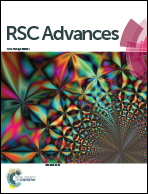Effects of microstructures on the compression behavior and phase transition routine of In2O3 nanocubes under high pressures
Abstract
The differences between the compression behaviors of nanocrystal systems and their bulk counterparts are generally attributed to the size and morphology effects. However, these effects may not be simply employed to deal with the contradictory results about In2O3 bulk and nanomaterials under high pressures. In this work, we intend to show that other than size and morphology, the effects of microstructure should play a key role in the compression behavior and phase transition routine of In2O3 cubical-shaped nanocrystals under high pressures. Two samples of In2O3 nanocubes, which have almost the same size, shape and exposed facets, are subjected to high pressure at room temperature. The In2O3 nanocubes with a lower density of microstructures undergo a first order phase transition at about 18.9 GPa, and the two phases coexist when the pressure is released. Whereas the In2O3 nanocubes with a higher density of microstructures show no sign of such a phase transition at pressures up to 33.4 GPa, a change of elastic properties at about 8.8 GPa may be observed instead. Thus, it is anticipated that controlling the microstructures of nanomaterials may be a potential route to modulate their structural and elastic behaviors under pressures.


 Please wait while we load your content...
Please wait while we load your content...